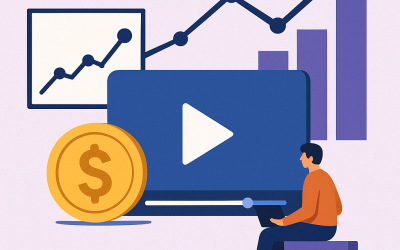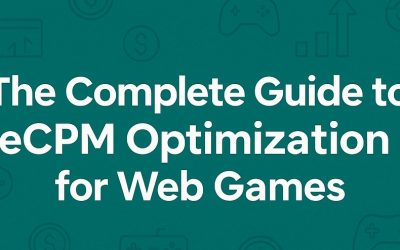First-Party Data & Privacy-First Monetization
Game monetization is undergoing a major shift. The growing global focus on privacy, combined with the decline of third-party tracking tools, has forced developers to rethink how they generate revenue. The solution lies in using first-party data and privacy-first monetization strategies that protect user trust while enhancing long-term value.
In 2025, building a sustainable and profitable game requires more than compelling gameplay. It requires ethical data practices, regulatory compliance, and a clear monetization strategy built around what you, as the developer, can control — the data you collect directly from your players.
This post will guide you through that transformation, showing how first-party data and privacy-first strategies can drive ad revenue, improve engagement, and future-proof your monetization efforts.
Contents
- 1 Why Privacy-First Monetization Is Now Essential
- 2 What Is First-Party Data and Why It Matters
- 3 Collecting First-Party Data the Right Way
- 4 Rethinking Monetization Through a Privacy-First Lens
- 5 Advanced Privacy-First vs. Traditional Monetization Analysis
- 6
- 7 Monetizing IAP and Subscriptions With First-Party Insights
- 8 Web Monetization Without Cookies
- 9 Choosing the Right Tools for Privacy-First Monetization
- 10 Future-Proofing Your Monetization Strategy
- 11 AppLixir Rewarded Video Ad
Why Privacy-First Monetization Is Now Essential
The pivot to privacy-first isn’t a temporary trend. It’s a permanent response to sweeping regulatory changes and evolving consumer expectations.
The introduction of laws like GDPR in Europe, CCPA in California, and similar regulations in Brazil, China, and India has placed strict limits on how companies can collect and use personal data. These laws demand explicit consent, offer users the right to opt out, and require companies to disclose how data is used.
On the platform side, Apple’s App Tracking Transparency (ATT) framework has forced developers to obtain permission before tracking users. Since its release, opt-in rates have dropped significantly, crippling user-level ad targeting. Meanwhile, Google is rolling out the Privacy Sandbox for Android and deprecating third-party cookies in Chrome, limiting traditional retargeting options.
The result? Developers who once relied heavily on third-party data now face lower CPMs, reduced fill rates, and less effective targeting. User acquisition costs have climbed, and traditional monetization strategies are no longer delivering the same returns.
But this shift has created a powerful opportunity. Developers that build a first-party data strategy — collecting behavioral, contextual, and engagement data directly from users — are unlocking higher ARPU, stronger retention, and more predictable ad revenue.
What Is First-Party Data and Why It Matters
First-party data is information that your users voluntarily provide or generate while engaging with your game. It includes everything from level progression and play frequency to ad interactions and purchase behavior.
Unlike third-party data, which is often aggregated from external sources and lacks user transparency, first-party data is collected in your own environment. You control it. You can use it to personalize offers, segment users, and improve ad targeting — all while staying compliant with privacy regulations.
Think of it as building your own private dataset. It’s clean, consent-based, and perfectly aligned with today’s regulatory landscape.
Collecting First-Party Data the Right Way
Collecting first-party data starts with transparency. Let users know what you’re collecting, why it matters, and how it benefits them. This might include behavioral data like how long they play, what levels they complete, or how often they engage with ads. You can also capture preference data, like language settings, notification opt-ins, or favorite game modes.
But rather than asking for everything upfront, consider progressive profiling. Start with essential data at onboarding, then ask for more as players progress. After they complete a level, you might prompt a short feedback question. When they join a guild or make a purchase, you could collect additional data relevant to that interaction.
Behavioral inference is another powerful method. For example, if a player retries a level multiple times, you can infer they prefer challenging content. If they spend time customizing avatars, they may respond well to cosmetic IAPs.
Collect contextually and respectfully — and always offer users control.
Rethinking Monetization Through a Privacy-First Lens
Privacy-first monetization means optimizing revenue without invasive tracking. It’s about using owned data to create experiences that are both valuable and ethical.
One of the best places to start is with rewarded video ads. These ads are already user-initiated and inherently respectful. But with first-party data, you can make them smarter.
By analyzing player behavior, you can time ads for maximum impact — such as offering extra lives before a difficult boss, or bonus currency after a major win. The key is understanding the user journey and fitting monetization into moments that feel organic.
This strategy improves ad completion rates and boosts revenue. Players are more likely to engage with ads when they feel relevant and well-timed. That translates into better CPMs, stronger eCPM, and improved ARPDAU.
Personalization also becomes easier with first-party insights. You can adjust the type of ads shown, match genres to player preferences, or scale rewards based on user engagement levels. This kind of customization isn’t possible when you rely solely on third-party targeting.
Advanced Privacy-First vs. Traditional Monetization Analysis
| Aspect | Traditional Model | Privacy-First Model | Business Impact |
|---|---|---|---|
| Data Source | Third-party cookies, IDFA, external data brokers | Direct user interactions, consented data collection | 40% more reliable attribution |
| Targeting Method | External behavioral profiles, look-alike audiences | In-game behavior, user-declared preferences | 25% higher conversion rates |
| Compliance Risk | High (potential fines, app store violations) | Low (built-in compliance by design) | Reduced legal exposure |
| User Trust | Low transparency, potential privacy concerns | High transparency, user control | 60% higher user satisfaction scores |
| Revenue Stability | Vulnerable to platform changes, regulatory shifts | Stable, owned data assets | 30% more predictable revenue |
| Competitive Advantage | Easily replicated, commoditized | Unique, proprietary insights | Sustainable differentiation |
Monetizing IAP and Subscriptions With First-Party Insights
First-party data also powers smarter IAP strategies. By analyzing in-game behavior, you can determine when a user is likely to convert and what offer will appeal to them most.
For instance, players who spend time browsing item stores but don’t buy might need a first-time discount. Users who retry levels often may respond well to power-up bundles. Those who make cosmetic changes frequently might be more inclined to purchase skins or avatars.
With dynamic pricing and personalized bundles, you can boost conversion rates while maintaining user satisfaction. Subscription models also benefit from behavioral triggers, offering ad-free modes or premium content to players who engage daily or reach specific milestones.
This isn’t guesswork — it’s a targeted monetization strategy grounded in real user behavior.
Web Monetization Without Cookies
For developers building browser games or HTML5 experiences, cookie deprecation presents real challenges. But first-party data collection offers a solution.
Rather than relying on cookies, use methods like local storage or server-side analytics to track user sessions and preferences. Create persistent but anonymous user IDs based on session behavior. Offer login options to link user data across platforms.
Platforms like AppLixir support privacy-compliant monetization for HTML5 games by using contextual targeting and server-side mediation — no personal data required. This allows you to show high-performing rewarded video ads without violating user trust.
The shift to first-party web monetization isn’t just possible — it’s more effective than ever when paired with the right strategy and tools.
Choosing the Right Tools for Privacy-First Monetization
To implement privacy-first monetization at scale, use platforms built with compliance and performance in mind.
AppLixir stands out as a privacy-first rewarded video platform for both mobile and web. It avoids SDK bloat, uses server-side mediation, and delivers premium demand without requiring personal user data. For developers using Unity or HTML5, it’s one of the easiest and most compliant ways to drive ad revenue.
You can also explore tools like Google’s Privacy Sandbox, Unity’s built-in consent management, and Firebase’s privacy-compliant analytics. These platforms help you collect, analyze, and act on user data without compromising trust or regulatory alignment.
Future-Proofing Your Monetization Strategy
The end of third-party cookies and the decline of device identifiers are not the end of monetization — they’re a reset. The future belongs to developers who can collect and use data ethically, offer real value in exchange for consent, and build monetization systems based on trust.
Start with a privacy audit. Remove unnecessary SDKs. Implement consent management early in the user journey. Begin collecting behavioral data you can act on. Then use it to create personalized ad experiences, smarter IAP offers, and loyalty-driven subscription models.
Success won’t come from volume alone. It will come from quality — of data, of experience, and of user relationships.
AppLixir Rewarded Video Ad
The future of game monetization is private, contextual, and owned. Developers who embrace first-party data now will unlock higher eCPMs, more effective ad placements, and stronger user loyalty — all without violating trust.
You don’t need to sacrifice performance to stay compliant. In fact, privacy-first design leads to better monetization over time. When users know their data is respected, they’re more likely to engage, convert, and stick around.
So don’t wait for regulations to force your hand. Make the shift now. Use first-party data to build better games, drive sustainable revenue, and lead the next generation of ethical monetization.
Privacy isn’t a constraint — it’s your competitive advantage.



